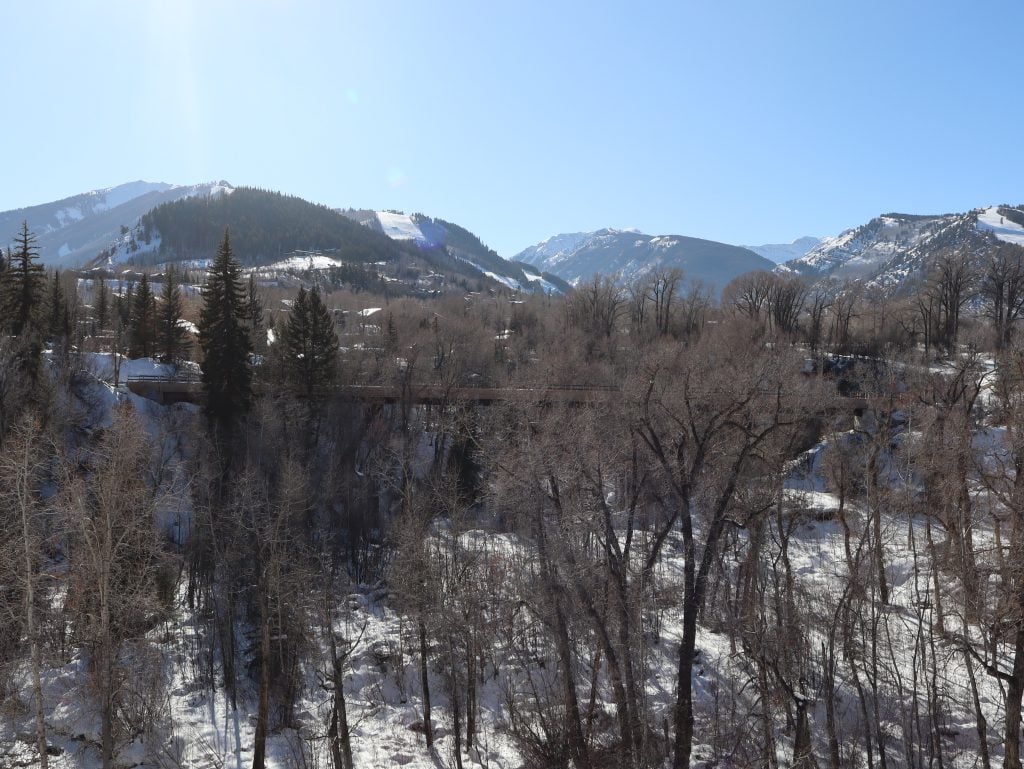Proponents for Aspen’s Referendum 1 Speak Out


Referendum 1, appearing on Aspen’s March ballot, proposes raising the voter threshold for changes to city-owned parks and open spaces from a simple majority of 50% plus one to 60%.
Proponents argue this amendment to the city charter ensures greater community consensus on critical decisions, while critics see it as potentially undemocratic.
Referendum 2, meanwhile, seeks to grant the Colorado Department of Transportation a permanent easement over the entirety of the Marolt Open Space, effectively removing the conditions currently tied to the Preferred Alternative for the Entrance to Aspen.
Barb Pitchford, an Aspen resident and advocate for Referendum 1, highlighted the broader implications of both measures.
“We have a serious traffic problem, a broken bridge, and a wildfire plan to address,” she said, framing the ballot questions in the context of longstanding challenges. “Referendum 1 raises the bar to 60% for the development of city-owned parks and open spaces. It’s important to stress that this applies only to city land — it’s not about private property. There’s a lot of misinformation out there.”
Pitchford emphasized that recreational uses of open space, such as converting a tennis court to a pickleball court, do not require voter approval under current rules. She pushed back against claims that a supermajority is undemocratic, pointing to examples in governance — like ratifying treaties or amending the Constitution — where higher thresholds are the norm.
“These decisions are so significant that they warrant a higher standard,” she said, citing the John Denver Sanctuary and Ute Cemetery as examples of protected spaces that already require heightened safeguards.
She also noted that Referendum 1 would eliminate snap elections on open space issues, which she said have been considered twice in recent years.
“With voter turnout for local elections at about 45%, compared to 75% for federal elections, we risk having a small minority make these critical decisions,” Pitchford said. She argued that requiring a 60% majority ensures decisions are backed by a broader consensus of the community.
On the other hand, Referendum 2 would fundamentally alter Colorado Department of Transportation’s control over the Marolt Open Space.
Pitchford expressed concerns about granting the Colorado Department of Transportation unrestricted access, calling it a “blank check easement” that removes protections established in the 1996 vote.
“This would allow CDOT to use all 79.5 acres without boundaries,” she said, adding that the current easement includes conditions like a 400-foot cut-and-cover tunnel, sensitive environmental design, and public approval of the final highway layout.
She warned that Referendum 2 would erase these safeguards and pave the way for decisions that may not align with the community’s values.
“This could be the last vote Aspen ever gets on the Entrance to Aspen,” she cautioned.
Citing Jacobs Engineering reports, Pitchford criticized the potential traffic implications of Referendum 2’s Preferred Alternative.
“The Split-Shot alternative, for example, shows increased congestion, particularly for residents of Cemetery Lane,” she said.
Redirecting traffic through the roundabout and adding a stoplight at Seventh Street would exacerbate delays, she argued, while creating new bottlenecks in the West End.
“The S-curves may slow traffic, but at least it’s still moving,” she said, adding that the proposed changes offer no real solutions to Aspen’s traffic challenges.
Pitchford also raised concerns about the broader impact of such changes on the community, including the loss of parking for Aspen-Pitkin County Housing Authority units near the proposed route.
“We can’t just shift the burden to one neighborhood in the name of the common good,” she said, emphasizing the need for balanced solutions.
She pointed out that studies, including one by the Aspen Institute, have consistently shown that expanding roads does not alleviate congestion but instead attracts more traffic.
While Pitchford acknowledged the importance of addressing traffic and evacuation concerns, she stressed the need for a holistic approach.
“Traffic counts have been declining for 20 years, thanks in large part to RFTA. Our real issue isn’t moving people onto buses; it’s managing congestion from cars and trucks,” she said.
She advocated for innovative solutions, such as autonomous shuttles and short-distance transit options, rather than defaulting to outdated plans.
“If we’re going to spend $500 million, let’s solve the whole problem, not just a small piece of it,” she said.
Neil Siegel, an Aspen resident and retired attorney, weighed in on Referendum 2, noting that the Colorado Department of Transportation already has the right to take two lanes through the Marolt Open Space under existing agreements.
“The question isn’t whether they can — it’s how much more they want,” he said, suggesting that the debate over the easement’s scope is largely symbolic.
Pitchford criticized the city’s approach to the Entrance to Aspen survey, calling it flawed for failing to prioritize fixing the aging Castle Creek Bridge.
“We’re looking at a 10- to 15-year timeline for a new bridge at this pace,” she said.
She stressed the urgency of maintaining the existing structure, which Siegel noted can no longer be resurfaced due to weight restrictions.
“The bridge is decaying, and CDOT doesn’t have the funds to begin planning,” Siegel said. “We’re fiddling while Rome burns.”
Wildfire preparedness further complicates the conversation, Pitchford noted.
“We don’t have a realistic evacuation plan,” she said, explaining that current models assume all cars leave in one direction, which she called impractical.
Instead, she advocated for defensible perimeters around Aspen, leveraging managed forests, ski runs, and open spaces to protect the community.
“Our goal isn’t to abandon the town — it’s to defend it,” she said.
Pitchford concluded by underscoring the importance of local control over key decisions.
“Marolt is our leverage to demand 21st-century solutions,” she said. “If we give CDOT the keys to Marolt, we’re out of the game. Our Entrance defines who we are. We say yes to Referendum 1 and hell no to Referendum 2.”
By: Westley CrouchI The Aspen Times I January 29, 2025